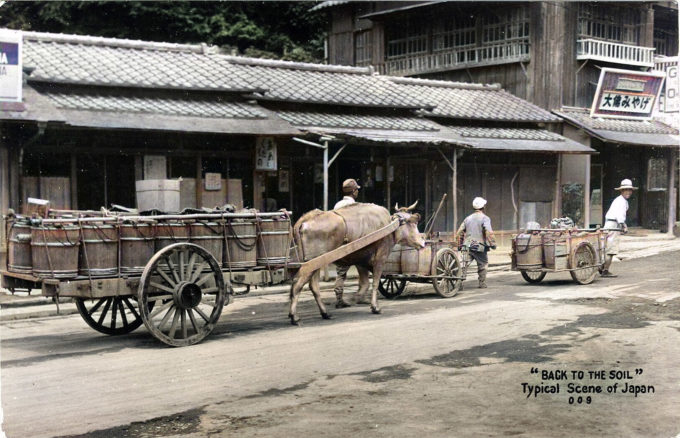“Another vivid memory of early Japan was the ‘honey bucket’ patrols. Some trucks but mostly slow moving wagons pulled by oxen.
“There was no central sewer system so the use of ‘out houses with buckets’ was the norm. Every morning collectors would make their rounds, picking up the buckets filled with human waste. These vehicles would hold around 20-25 of these wooden buckets. I presume they would replace the filled buckets with empties, which would be collected next time.
“Many of the streets were very narrow and traffic was slow, you always hoped you wouldn’t be stuck too closely behind a collecting vehicle! The wastes were taken to the nearby farming areas and deposited in concrete vats where long handled paddles were used to mix the contents with water.
“From there the mixture would be ladled into buckets and … taken to the fields and poured around plants. I was told it was excellent fertilizer.”
– Living In Occupied Japan, 1946 to 1949, Col. Francis H. Potter, USAF (Ret.), 2013

“Back to the soil”, c. 1950. ‘Honey buckets’ (in Japanese: noson kangen, lit. ‘send back to the farm village’) were wooden barrels used to hold and transport human waste (‘night soil’) for use as fertilizer in rural areas. They were ubiquitous during the Occupation (1945-1952), especially in metropolitan Tokyo where the night soil disposal system had been greatly disrupted by wartime bombing and the city’s primitive sewage system was in need of major repairs. (Colorized)
See also:
Yodobashi (Shinjuku), Tokyo, c. 1910.
“Agronomical manuals dating to the sixteenth century [in Japan] spelled out how human excrement could be combined with other forms of organic matter before being applied to the soil of vegetable plots.
“…When the city of Tokyo planned to invest in sewer infrastructure in 1914, for example, agricultural associations protested that ‘to our country’s farmers excrement is a precious economic resource. To throw it away by flushing it into sewers would, along with affecting farmers nearby Tokyo, also hurt urban residents by raising the price of agricultural products.’ Indeed, until the Pacific War, Tokyo’s municipal government preferred to work with commercial night soil dealers to maintain and revamp existing distribution networks rather than invest in comprehensive wastewater sewers.
“By 1944, however, as the war situation deteriorated, worsening shortages of fuel, labor, and matériel threatened to bring night soil collection in Tokyo to a standstill … By March, so much shit was being dumped directly into urban water bodies that ‘the moss on the riverbank at Asakusa turned a golden color.’ That month, the mayor’s office began discussions with the Seibu and Tobu railway companies to transport excrement by what were euphemistically known as ‘golden trains.’ (The idea of transporting excrement by rail was not new in itself either. As early as 1907 the Tokyo Fertilizer Company had contracted with Tobu to freight night soil from urban areas out to rural Saitama.)
“… By the end of the war [in 1945] the city’s excrement disposal system had clearly fallen into disarray. [E]ven excrement that did make it out to the urban periphery was increasingly applied to crops as raw sewage rather than being processed to eliminate parasites. In a report submitted to Supreme Commander Allied Powers (SCAP) in October 1945, the sanitation department emphasized the degree to which its operations had been impacted by the war … The report then appealed for SCAP’s help in restoring the prewar system of noson kangen (‘returning [excrement] to the farming villages from whence it came’), including a long shopping list of resources required in order to do so: more workers, vehicles, spare parts, fuel, and lumber for buckets and pails.
“[O]ne of the ironies of Japan’s postwar austerity was that demand for urban excrement soon spiked, and the night soil trade became a seller’s market once more, to the point where most urban residents no longer had to pay collectors a fee for their services. Several factors may help to explain this alchemic transformation in the value of shit. Military demobilization, combined with the widespread shuttering of factory gates, meant no shortage of people willing to haul shit to make ends meet. Moreover, with chemical fertilizer production crippled, many farmers had little option but to go back to using night soil.
“Unsurprisingly, the circumstances allowed scoundrels to flourish … The Asahi Shimbun complained that some brokers were resorting to old tricks, such as watering down their product to make it go further. With the breakdown of regulation by the sanitation department, farmers also seem to have grown less scrupulous in adhering to hygienic treatment of night soil. By one 1948 estimate, 80 percent of Japanese suffered some sort of gastrointestinal parasite, largely spread via human excrement.
“… The long-term solution to the excrement problem, as SCAP saw it, lay in restoring Japanese chemical fertilizer production so as to obviate farmers’ reliance on night soil altogether. Fertilizer manufacturers were thus exempted from the general order dismembering the large industrial conglomerates [zaibatsu] that were seen as responsible for fueling Japanese military aggression.
“The result was that Japan’s chemical fertilizer industry rebounded during Occupation years with unparalleled speed. By the end of the war, nitrogen fertilizer production had ground to a halt. With SCAP’s blessing, however, by 1949 it had already exceeded its prewar peak.”
– Attacked by Excrement: The Political Ecology of Shit in Wartime and Postwar Tokyo, by Paul Kreitman, 2018

